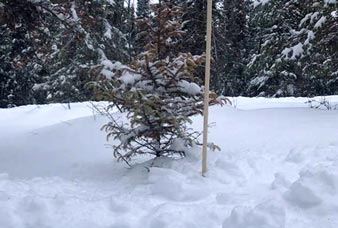Measuring the Depth of Snow
Early Years (Age 3 – 6)
Curriculum Goal
Kindergarten: Demonstrating Literacy and Mathematics Behavior
- Ask questions about and describe some natural occurrences, using their own observations and representations (14.1)
- Select an attribute to measure (e.g., capacity), determine an appropriate non-standard unit of measure, and measure and compare two or more objects (16.1)
- Investigate strategies and materials used when measuring with non-standard units of measure (16.2)
Kindergarten: Belonging and Contributing
- Describe what would happen if something in the local environment changes (e.g., if trees in a park were cut down, if the pond dried up) (29.2)
Kindergarten: Problem Solving and Innovating
- Make predictions and observations before and during investigations (13.2)
- Communicate and record results and findings either individually or in groups (24.5)
Context
- Students should have prior experience with non-standard measurement.
- This lesson will begin with a full-class discussion in the classroom.
- The activity will take place outside in the snow.
Materials
- Measuring Stick
- Unifix cubes
- Pen and paper
- Masking tape
- Snow-covered environment
Lesson
Introduction:
- Facilitate a discussion with students about measuring snow:
- How can we measure snow?
- How might we find out how deep the snow is?
- How can we keep track of how deep the snow is over time?
Lesson:
- Select a space outside to measure the snow all winter (Preferably a space where snow will accumulate without being walked on or shoveled away).
- Explain to students that we can measure how deep the snow is with a measuring stick. Ask students whether the depth of the snow will change over the winter season.
- Will it increase or decrease? Will it be both?
- Have students predict the depth of the snow. Encourage them to show their predictions using their hands.
- Use the measuring stick to measure their prediction. Note their prediction.
- Encourage students to use the measuring stick to determine the snow’s depth. The educator may need to model how to measure (e.g., placing the measuring stick in the snow, perpendicular to the ground).
- Place a piece of masking tape at the height of the snow on the measuring stick.
- Take the class inside and have students use unfix cubes along the length of the stick to determine the depth of the snow.
- Count how many unifix cubes deep the snow is and record the results.
- Compare this result with their predictions.
Closure:
- Ask the students to think about how the depth of the snow will change over the duration of winter:
- What will happen to the depth of the snow when it becomes warmer outside?
- What will happen when it snows more?
- What will happen if it rains?
- In the classroom, create a graph to display the date and the number of cubes used to measure the depth of the snow.
- As a class, look at the weather forecast and make predictions for the next time you will measure the snow.
- Continue to measure and graph this location throughout the winter.
Extensions:
- Consider measuring different locations (e.g., areas exposed to sun vs. shaded areas) to compare with the location your class originally started to measure.
- Explore the snow using different measures:
- Volume, mass, temperature.

Look Fors
- Are students using the measurement tools accurately (e.g., measuring the entire length of the imprint, ensuring the measurement tool is straight)
- Can students reasonably predict and explain why the depth of the snow will change over time (e.g., referring to the weather forecast or location of the snow)?
- Do students offer suggestions for other types of measurements (e.g., volume, mass, temperature)?
- Are students attempting to determine the difference between their predictions and their actual findings?
Share this lesson
Share on facebook
Share on twitter
Share on email
